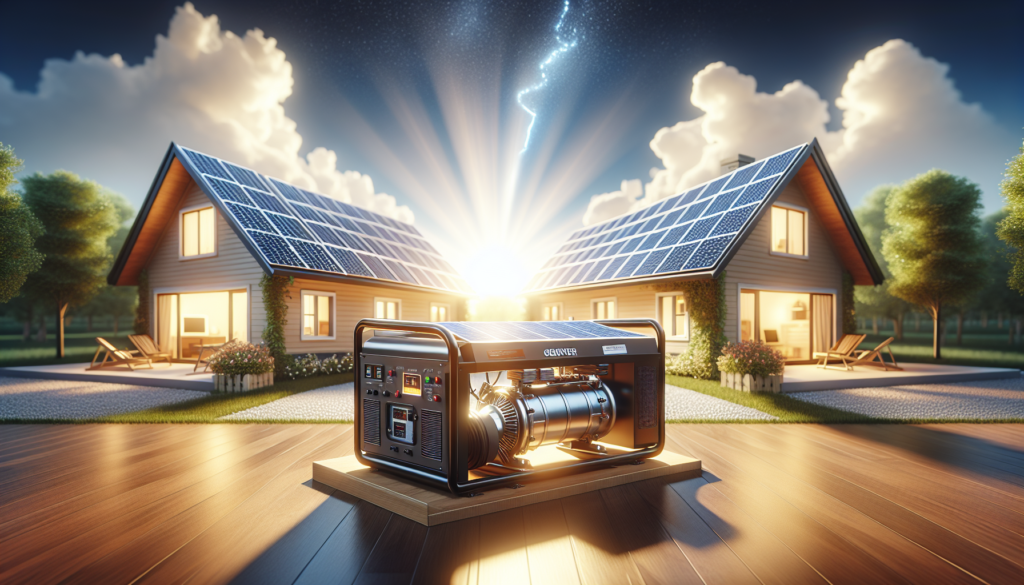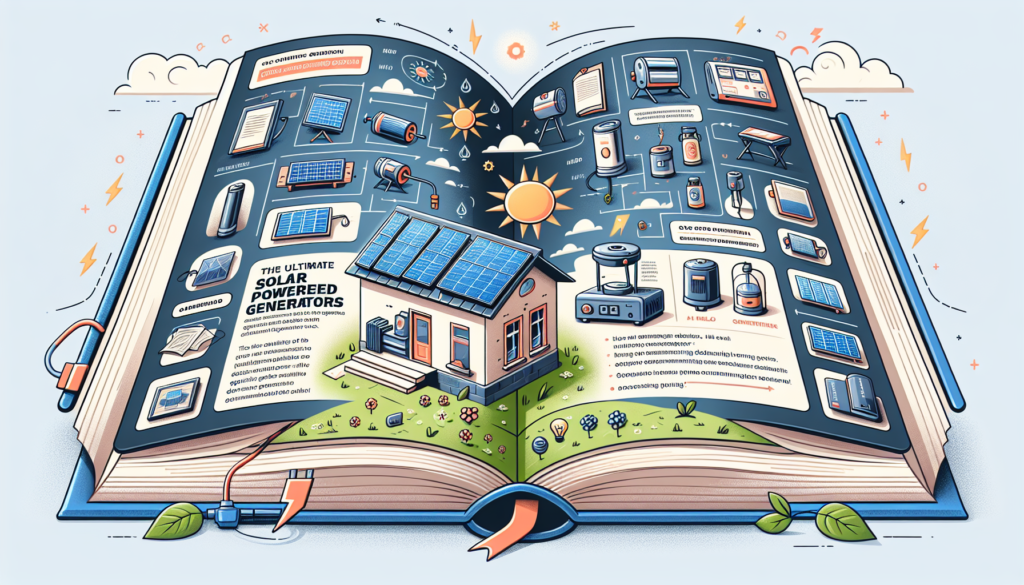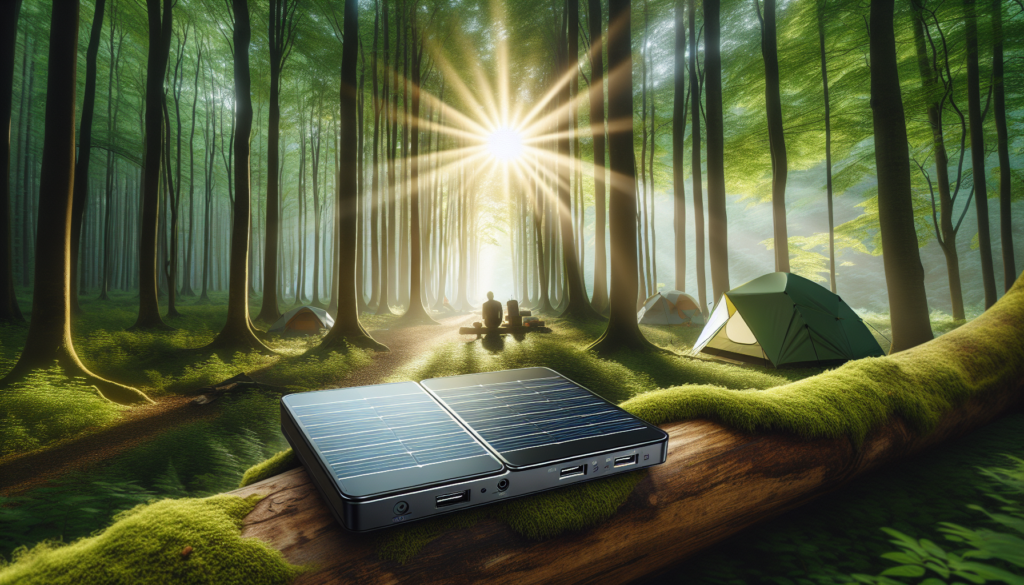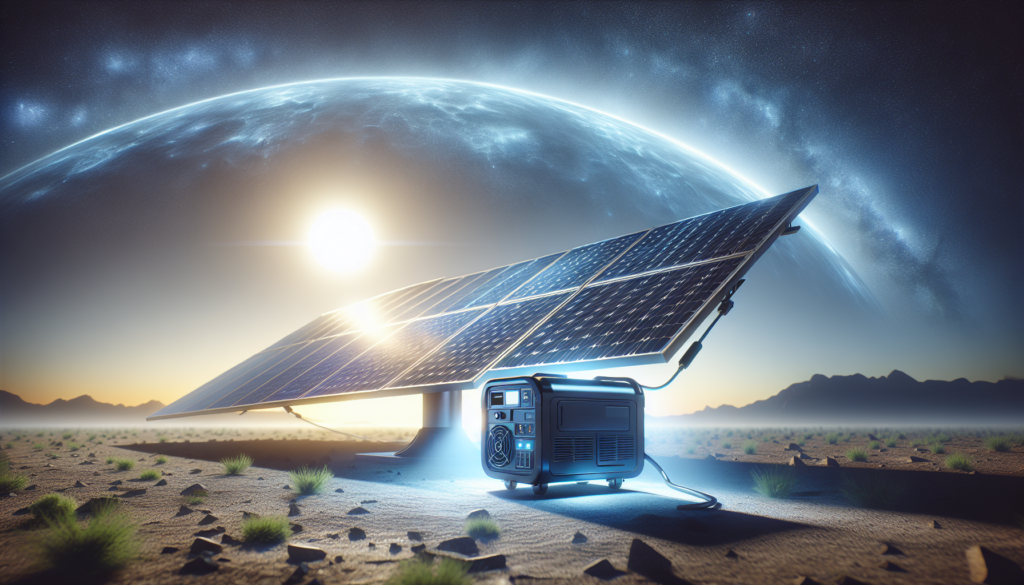Imagine never having to worry about losing power during a storm or paying hefty electricity bills again. With the rise of renewable energy, solar powered generators for home use have become an increasingly popular and cost-effective solution. Harnessing the power of the sun to generate electricity, these innovative devices provide a sustainable and reliable source of energy for your household needs. In this comprehensive guide, we will explore everything you need to know about solar powered generators for home use, from how they work and their benefits, to choosing the right one for your specific needs and installation tips. Get ready to discover a greener and more efficient way to power your home with the ultimate guide to solar powered generators.
The Ultimate Guide to Solar Powered Generators for Home Use
I. How do Solar Powered Generators Work?
Solar powered generators harness the energy from the sun to generate electricity. They consist of four main components: photovoltaic (PV) panels, charge controller, battery bank, and inverter.
A. Photovoltaic (PV) Panels
PV panels are the primary component of a solar powered generator. They contain numerous solar cells that convert sunlight into direct current (DC) electricity. The panels are typically mounted on a roof or in an area with maximum sunlight exposure.
B. Charge Controller
The charge controller regulates the amount of current flowing from the PV panels to the battery bank. Its main function is to prevent overcharging or discharging of the batteries, ensuring their longevity and optimal performance.
C. Battery Bank
The battery bank stores the electricity generated by the PV panels. It acts as a reservoir, supplying power during periods of low sunlight or at night when the panels are not producing electricity. Deep-cycle batteries, such as lead-acid or lithium-ion batteries, are commonly used in solar powered generators.
D. Inverter
The inverter converts DC electricity from the battery bank into alternating current (AC) electricity, which is the type of power used in most household appliances and devices. This allows you to power a wide range of electronic devices directly from the generator.
II. Advantages of Solar Powered Generators
Solar powered generators offer numerous advantages that make them a popular choice for homeowners seeking a reliable and sustainable power source.
A. Renewable and Sustainable
Solar power is a renewable energy source, meaning it will never run out as long as the sun continues to shine. By utilizing solar energy, you can reduce your dependence on fossil fuels and contribute to a more sustainable future.
B. Environmentally Friendly
Solar powered generators have a significantly lower carbon footprint compared to traditional generators that rely on fossil fuels. They produce clean energy without emitting harmful greenhouse gases or pollutants, helping to protect the environment and reduce air pollution.
C. Cost-effective
While the initial investment may be higher, solar powered generators can provide long-term cost savings. Once installed, the sun’s energy is free, and you can potentially offset or eliminate your monthly electricity bills. Additionally, solar powered generators require minimal maintenance, further reducing operating costs.
D. Quiet and Low Maintenance
Unlike noisy gas or diesel generators, solar powered generators operate silently, creating a peaceful environment. Additionally, they have fewer moving parts, resulting in less maintenance and fewer chances of mechanical failure.
E. Portable and Versatile
Solar powered generators are available in various sizes and designs, making them highly portable and versatile. They can be used for a wide range of applications, such as camping trips, outdoor events, or as a backup power source during emergencies.

III. Determining Your Power Needs
Before purchasing a solar powered generator, it is crucial to determine your power needs to ensure you choose the right system for your requirements.
A. Calculating Daily Energy Consumption
Start by assessing your energy consumption by keeping track of the wattage and usage time of your household devices and appliances. This will help you estimate the amount of energy you need to generate daily.
B. Understanding Power Ratings
Familiarize yourself with power ratings, such as watts and voltages, to understand the energy requirements of your devices. This will help you determine the capacity and output of the solar powered generator you need.
C. Assessing Load Types and Usage Frequency
Consider the types of loads you will be powering with the generator and their frequency of use. Some appliances, like refrigerators or air conditioning units, require a higher surge of power to start up than what they consume during regular operation.
D. Estimating Backup Power Duration
Determine how long you would like your solar powered generator to provide backup power during outages or periods of low sunlight. This will help you gauge the battery capacity needed to meet your power requirements.
IV. Choosing the Right Solar Powered Generator
Selecting the right solar powered generator involves considering various factors to ensure it meets your specific needs and preferences.
A. Generator Capacity and Output
Choose a generator with sufficient capacity to meet your daily energy consumption. Consider factors like peak load demands, energy efficiency of appliances, and potential future expansions.
B. Battery Capacity and Type
The battery capacity determines how much energy can be stored and used when the sun is not shining. Evaluate whether lead-acid or lithium-ion batteries are a better fit for your needs, considering factors such as lifespan, maintenance requirements, and cost.
C. Portability and Weight
If you plan to use the generator for outdoor activities or emergencies, portability is essential. Consider the weight and size of the generator to ensure it is convenient and easy to transport.
D. Noise Level
For residential use, a quiet generator is important to maintain a peaceful environment. Look for generators with noise-reducing features to minimize disruptions.
E. Durability and Weather Resistance
Ensure the generator is built to withstand various weather conditions, especially if you live in an area prone to extreme temperatures, high humidity, or heavy rainfall.
F. Additional Features and Accessories
Explore additional features and accessories, such as built-in USB ports, LED lights, or expandability options, that can enhance the functionality and convenience of the solar powered generator.

V. Setting Up Your Solar Powered Generator
Proper installation is crucial to ensure optimum performance and efficiency of your solar powered generator.
A. Determining the Location
Choose a location with maximum sunlight exposure, typically a south-facing area with minimal shade. Consider factors like mounting options, clearance requirements, and proximity to the battery storage area.
B. Installing Photovoltaic Panels
Follow the manufacturer’s instructions to mount the PV panels securely. The panels should be positioned at an optimal angle to maximize sunlight absorption. Regularly clean the panels to remove dirt or debris that can affect their efficiency.
C. Connecting the Charge Controller
Place the charge controller near the battery bank and connect it to the PV panels and batteries following the provided wiring diagram. Ensure all connections are secure and insulated to prevent any electrical hazards.
D. Setting Up the Battery Bank
Position the battery bank in a well-ventilated area. Connect the batteries in the correct series or parallel configuration, following the manufacturer’s guidelines. Securely attach the battery cables, taking care to connect the positive and negative terminals correctly.
E. Connecting the Inverter
Connect the inverter to the battery bank using appropriate cables, ensuring proper polarity. Take care to follow safety precautions while working with high-voltage connections.
F. Testing and Monitoring the System
Once the system is set up, carefully review the connections and test the system to ensure it is functioning correctly. Monitor the performance of the PV panels, battery bank, and inverter regularly to identify any issues or efficiency improvements.
VI. Maintaining Your Solar Powered Generator
Proper maintenance is essential to maximize the lifespan and efficiency of your solar powered generator.
A. Cleaning the Photovoltaic Panels
Regularly clean the PV panels to remove dirt, dust, or debris that can hinder their performance. Use a soft cloth or sponge with mild soap and water, avoiding abrasive materials that can cause damage.
B. Monitoring and Maintaining Battery Performance
Check the battery bank regularly to monitor its charge level and overall performance. Follow the manufacturer’s guidelines for maintenance, which may include periodic equalization or watering for lead-acid batteries.
C. Checking and Cleaning the Inverter
Inspect the inverter for any signs of dust, debris, or damage. Clean the vents or fans to prevent overheating. Consult the manufacturer’s instructions for specific cleaning guidelines.
D. Maintaining the Charge Controller
Inspect the charge controller for loose connections or signs of wear. Ensure the controller is operating correctly by monitoring battery voltage, charging current, and system status indicators.
E. Replacing Worn-out Components
Over time, certain components of the solar powered generator may wear out or become less efficient. Regularly inspect and replace components like batteries or PV panels as needed to ensure optimal system performance.
VII. Tips for Using Solar Powered Generators Efficiently
Follow these tips to maximize the efficiency and effectiveness of your solar powered generator:
A. Optimize Sunlight Exposure
Regularly check for any obstructions or shading that may affect the performance of the PV panels. Trim overhanging branches or remove any debris that may accumulate on the panels.
B. Manage Energy Usage
Be mindful of energy consumption and prioritize essential devices during periods of limited sunlight or low battery capacity. Adjusting settings or using energy-saving modes can help prolong backup power duration.
C. Monitor Battery Levels
Frequently check the battery levels to ensure they are adequately charged. Avoid excessively discharging the batteries, as it can reduce their lifespan.
D. Use Energy-efficient Appliances
Consider using energy-efficient appliances and LED lighting to minimize power consumption. Energy-efficient devices require less energy, allowing your solar powered generator to operate for a longer duration.
E. Consider Time of Use
Take advantage of peak sunlight hours to charge the battery bank and power high-energy-consuming devices. Plan your energy usage during times when the PV panels are generating the most electricity.
F. Plan for Long-term Storage
If you anticipate extended periods of non-use, properly store your solar powered generator to maintain its performance. Follow manufacturer guidelines regarding battery storage, panel protection, and system shutdown procedures.
VIII. Safety Considerations
When working with solar powered generators, it is essential to prioritize safety to minimize any potential risks.
A. Electrical Safety
Take precautions to prevent electrical hazards. Ensure all connections are securely insulated, and use appropriate safety equipment when working with high-voltage components.
B. Fire Safety
Position the generator and all components away from flammable materials. Be cautious when operating the generator near combustible substances to prevent fire accidents.
C. Protection against Overcharging or Discharging Batteries
Properly set up and maintain the charge controller to prevent overcharging or discharging of the batteries, which can lead to damage or safety hazards.
D. Lightning and Surge Protection
Install surge protectors and lightning arrestors to safeguard the solar powered generator from power surges or lightning strikes. Consult with a professional electrician for expert assistance.
IX. Common Troubleshooting and FAQs
Despite their reliability, solar powered generators may encounter occasional issues. Here are some common troubleshooting tips and frequently asked questions to assist you:
A. Identifying and Fixing Power Output Issues
If you are experiencing a lack of power output, ensure all connections are secure and that the PV panels are not obstructed. Check the battery charge level and the condition of the inverter. Consult the manufacturer’s troubleshooting guide or seek professional assistance if necessary.
B. Addressing Battery Problems
Inadequate battery performance may be due to insufficient charging or battery deterioration. Verify the charge controller settings and ensure the PV panels are producing sufficient energy. If necessary, consider replacing the batteries or consult a professional for evaluation.
C. Dealing with Inverter Malfunctions
If the inverter fails to convert DC to AC electricity, check the connections, voltage settings, and input/output configurations. Inspect for any damage or signs of overheating. Refer to the manufacturer’s troubleshooting guide or seek professional help if needed.
D. Handling Overcast Days or Low Sunlight
During periods of limited sunlight, prioritize energy usage and conserve power. Reduce non-essential appliance usage and consider alternative power sources when necessary.
E. Frequently Asked Questions
Address common queries related to solar powered generators, such as their installation process, pricing considerations, maintenance requirements, and potential limitations. Provide detailed and accurate information to assist readers in making informed decisions.
X. Conclusion
Solar powered generators offer a sustainable and reliable solution for powering your home. Understanding how they work, determining your power needs, choosing the right generator, and properly setting it up and maintaining it are crucial steps to ensure optimal performance and longevity. By following safety guidelines and implementing efficiency strategies, you can enjoy the benefits of clean, renewable energy while minimizing your environmental impact. Invest in a solar powered generator today and embrace a greener future.
A. Summary of Key Points
In this comprehensive guide, we explored the workings of solar powered generators, their advantages, and how to determine your power needs. We discussed the factors to consider when choosing the right generator, the proper setup and maintenance procedures, and tips for efficient usage. Safety considerations, troubleshooting tips, and frequently asked questions were also addressed.
B. Final Thoughts
Solar powered generators offer a sustainable and cost-effective solution for homeowners seeking a reliable power source. With proper understanding, careful planning, and regular maintenance, you can enjoy the benefits of clean energy and minimize your reliance on traditional fossil fuel-powered generators. Embrace the power of the sun and make a positive impact on the environment with a solar powered generator for your home.




